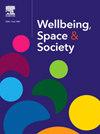COVID-19大流行期间精神健康状况下降:感染风险、社会脱节以及个人和社区层面收入损失的作用
IF 2.2
Q2 GEOGRAPHY
引用次数: 0
摘要
在2019冠状病毒病大流行的最初几个月,心理健康水平下降是在感染风险、社会联系减少和担心收入损失的背景下发生的。然而,这些相互关联的挑战以不同的方式随个人和社区特征而变化。本研究利用根本原因理论和迪尔凯姆理论,就这些挑战对心理健康的潜在后果提出了对比假设,并利用疫情爆发头几个月对波士顿居民进行的个人层面调查数据,以及来自人口普查和其他来源的社区层面数据,对这些假设进行了检验。封锁后社区流动性的更快增长速度,而不是更低的感染率,与自我报告的心理健康下降程度较低有关。有色人种报告的经济影响比白人居民更大,但报告的心理健康下降幅度较小。女性、年轻人和受教育程度较高的人以及感到孤独的人对心理健康的负面影响更大。更多的在线活动与心理健康下降有关,除非在线活动是与朋友和家人或宗教社区的一部分。这些发现加深了对黑白心理健康悖论的理解,强调了社会联系模式在解释迪尔凯姆理论所预测的大流行心理影响方面的重要性,并应为在未来大流行中减少这些影响的规划提供信息。本文章由计算机程序翻译,如有差异,请以英文原文为准。
Diminished mental well-being in the COVID-19 pandemic: The role of infection risk, social disconnection, and income loss at the individual and neighborhood levels
The decline in mental well-being in the early months of the COVID-19 pandemic occurred in the context of risk of infection, diminished social connection, and fear of income loss. However, these interrelated challenges varied in different ways with individual and neighborhood characteristics. This study poses contrasting hypotheses about the potential consequences of these challenges for mental health, drawing on fundamental cause theory and Durkheimian theory, and tests these hypotheses with individual-level data from a survey of Boston residents in the first months of the pandemic and neighborhood-level data from the census and other sources. Faster rates of post-lockdown increase in neighborhood level mobility, not lower infection rates, were associated with less self-reported decline in mental well-being. Persons of color, who reported greater economic impact than White residents, still reported less decline in mental well-being. Women, younger and more educated persons, and those who felt lonelier reported more adverse impact on mental well-being. More online activity was associated with decreased mental well-being, except when online engagement was with friends and family or was part of a religious community. These findings deepen understanding of the Black-White mental health paradox, highlight the importance of patterns of social connection in explaining the pandemic’s psychological effects as predicted by Durkheimian theory, and should inform planning to lessen these effects in future pandemics.
求助全文
通过发布文献求助,成功后即可免费获取论文全文。
去求助
来源期刊

Wellbeing Space and Society
Social Sciences-Social Sciences (miscellaneous)
CiteScore
2.70
自引率
0.00%
发文量
46
审稿时长
124 days
 求助内容:
求助内容: 应助结果提醒方式:
应助结果提醒方式:


